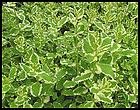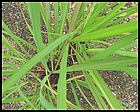
|
 |
|
|||||
|
Why Not Grow Your Own Herbal Tea?
 Bee balm. Besides splashing the summer garden with shades of red, pink, violet or white, the flowers of bee balm (Monarda didyma) lend a citrus-mint flavor to tea. Flowering lasts from midsummer until early fall. Also called Bergamot or Oswego Tea, bee balm puts up with a wide range of soil and light conditions but prefers full sun and moist, rich soil. Bee balm. Besides splashing the summer garden with shades of red, pink, violet or white, the flowers of bee balm (Monarda didyma) lend a citrus-mint flavor to tea. Flowering lasts from midsummer until early fall. Also called Bergamot or Oswego Tea, bee balm puts up with a wide range of soil and light conditions but prefers full sun and moist, rich soil.
The plant grows two to three feet tall and two feet wide (it tends to grow taller in shade and needs staking) and can spread via rhizomes. Bees and hummingbirds will also like that you've included this perennial in the garden. Avoid overhead watering to help ward off powdery mildew; 'Elsie's Lavender' (lavender) and 'Cherokee' (rose-pink) are among the most resistant. Most cultivars are hardy to Zone 4. Lemongrass. A favorite ingredient in Thai cooking, lemongrass (Cymbopogon citrantus) also shows up in many herbal tea blends. The plant is a stately clump of fairly fine-bladed grass, two to five feet tall, that grows in full sun or light shade. Gardeners north of Zone 8b (Zone 9, to be sure) will need to overwinter this tender annual as an indoor container plant.
 Mint. This family of perennials alone offers loads of tea options, namely peppermint (Mentha x piperita), spearmint (Mentha spicata), and a host of special flavors—apple, orange, lemon, pineapple, even chocolate. Lemon balm (Melissa officinalis) also offers a lemon-mint flavor. The newest leaves have the most flavor; use fresh for hot tea as well as flavoring lemonade and iced tea. Mint. This family of perennials alone offers loads of tea options, namely peppermint (Mentha x piperita), spearmint (Mentha spicata), and a host of special flavors—apple, orange, lemon, pineapple, even chocolate. Lemon balm (Melissa officinalis) also offers a lemon-mint flavor. The newest leaves have the most flavor; use fresh for hot tea as well as flavoring lemonade and iced tea.
Most mints are notoriously invasive. If you're adding mint to the garden, either grow it in containers or, if you want it in the ground, put a tall (12 inches plus), bottomless plastic container in the planting hole and plant the mint inside. Leave about two inches of rim exposed above ground, then keep an eye out for runners. Most mints are hardy to Zone 4. Chamomile. A sweet miniature-daisy-like plant with feathery foliage, German chamomile (Matricaria recutita) is a trouble-free annual that's easily grown from seed and self-sows readily, and it's the type of chamomile that's usually used in making tea. Roman chamomile (Chamaemelum nobilis) is a perennial, hardy to Zone 6, but it lends a somewhat bitter flavor to tea. Give chamomile a sunny site and moist, well-drained soil. This time of year you may still find potted plants in some garden centers and specialty nurseries. Don't mistake this chamomile for the common roadside plants, scentless chamomile (Anthemis arvensis) or mayweed chamomile (Anthemis cotula), both noxious weeds in many areas.
Rose hips. Round fruits that develop from spent flowers. If you want roses to concentrate on flower production, deadhead each bloom after its prime so it doesn't spend all its energy producing seed. If you want tea, however, leave the roses to wither on the bush and in time, hips will develop. A good compromise: let roses have their big heyday in spring and early summer, and then let them work on producing hips.
Making Herbal Tea
1. To make tea, use one tablespoon fresh leaves or flowers (as appropriate, depending on the species). If the plant material is dried, use one teaspoon. 2. Add the herb--or a blend of herbs--to a tea ball or a steeping cup that's resting in a mug. If desired, you can include some clippings of stevia, a natural sweetener, with the tea herbs 3. Pour hot--but not boiling--water in the mug and let steep for five minutes or less. 4. Add honey, lemon or sugar as desired. Caution: If you're not used to drinking fresh herbal teas, start slowly. Make sure you know the identity of the plant you're using to make tea, and be watchful for adverse reactions. Finally, don't use any leaves or flowers that have been treated with pesticides. (Courtesy Marie Hofer, Gardening editor, HGTV.com)j DVO would love to publish your article, prose, photography and art as well as your cooking, kitchen and nutrition tips, tricks and secrets. Visit the Newsletter Submission / Win Win for All section in our Forum for more information and details.
OTHER GREAT ARTICLES
• Keeping it Compact! • Healing Weeds • Yummy Smoothies! • Summer Corn on the Cob • Gingersnap Chicken • Homemade Cones • 5-Day Meal Plan with "Dovetail Tips" for Big Time Savings! • Men Are Just Happier People • Cook'n Club Cover Page |
|
Terms & Conditions | Webmaster | Privacy Policy | Unsubscribe  © 2007 DVO Enterprises, Inc. All rights reserved. Sales: 1-888-462-6656 |




